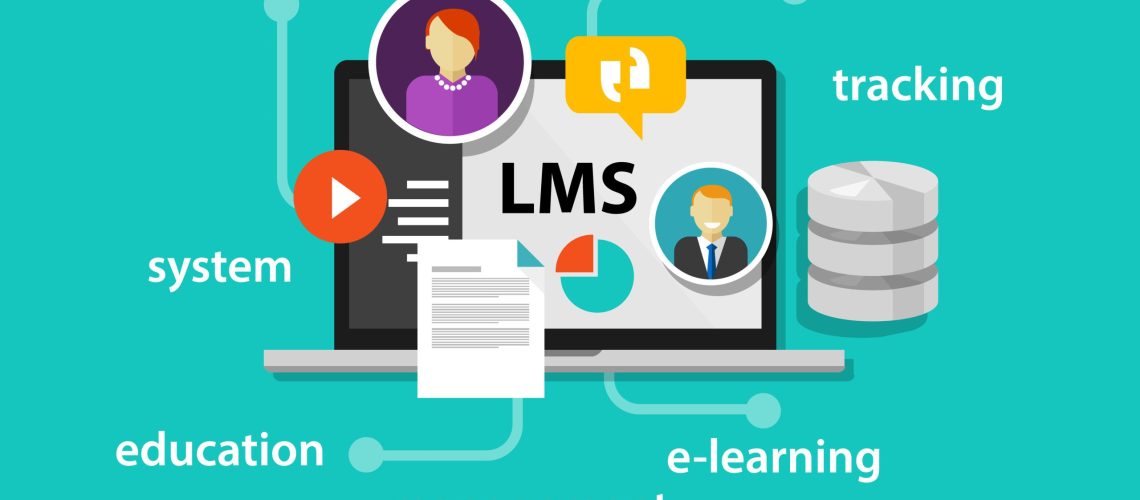What if there’s a centralized hub for all your training needs that’s accessible anytime, anywhere? Wouldn’t it make your employees’ life easier? That’s the power of learning management systems or LMS(s). No wonder the number of LMS software users is already at 73.8 million, as per a 2023 report. (1)
Who benefits from LMS platforms?
LMS solutions streamline an online training program’s creation, delivery, and management.
In the business world, an LMS, which acts as employee training software, revolutionizes workplace learning. This solution creates a culture of continuous learning and caters to a wide array of stakeholders within an organization:
- Business owners and managers. LMS platforms streamline training processes, reduce costs, and offer valuable insights into employee performance.
- HR professionals. They help simplify onboarding, ensure compliance with training regulations, and track employee certifications.
- Employees. They offer flexible access to learning materials, personalized learning paths, and opportunities for professional growth.
- Training specialists. LMS platforms allow for the creation of engaging learning experiences, monitor learner progress, and tailor training content to meet organizational needs.
Latest developments in the LMS landscape
The corporate learning landscape is ever-changing. And with it, the LMS industry also evolves.
The integration of artificial intelligence (AI) is a key trend in the workplace: 64% of businesses see AI as a productivity boost. In LMSs, AI tailors learning experiences to individual needs, automates assessment processes, and offers intelligent feedback to learners. (2)
There’s also a stronger focus on mobile learning now than ever. That’s also expected, with the number of mobile users worldwide likely rising to 7.49 billion next year. Consequently, LMS platforms are focusing on responsive design and mobile app integrations to facilitate seamless learning experiences on the go. (3)
Best LMSs
Are you a large enterprise or a small business? Regardless, there’ll be an LMS solution that suits your needs. Let’s explore below five of the best learning management systems currently available in the market.
TalentLMS
First on our list is TalentLMS, which is perfect for small—and midsize businesses. This budget-friendly LMS solution doesn’t compromise on user experience. While affordable, TalentLMS provides a seamless interface and intuitive tools for creating learning content.
Key Features
- Content authoring with generative AI (TalentCraft): Course creators can use the power of generative AI through TalentCraft to effortlessly create high-quality course content.
- Gamification: With TalentLMS, you can enhance learner engagement and motivation by incorporating gamification elements into your courses.
- Drag-and-drop course builder: This feature enables you to effortlessly design engaging courses by incorporating text, images, videos, and even quizzes.
- SCORM and xAPI compliance: Do you want to upload existing SCORM-compliant courseware? You can do it on TalentLMS. Or you can leverage xAPI to track learner interactions within your courses.
- Automated workflows: TalentLMS also streamlines administrative tasks. It provides progress tracking reports, automated reminders, and enrollment triggers.
Why we chose it
So, what sets TalentLMS apart? Its affordability and user-friendliness stand out. With competitive pricing plans, it becomes an ideal option for growing businesses in need of a reliable cloud-based LMS that can enhance their training efforts as they expand.
The platform also features a user-friendly interface. Minimal to no technical expertise is required, so smaller teams without dedicated training administrators greatly benefit from it.
Drawbacks
TalentLMS is not the best fit for academic learning and for selling courses via eCommerce.
Pricing
TalentLMS offers a free plan. Pricing starts at $69/month.
Moodle
Next is Moodle LMS. Are you seeking an endlessly customizable platform? If yes, then this one’s for you. It’s an open-source LMS that allows users to tailor the learning experience to their specific needs.
Key features
With Moodle, you’ll enjoy:
- Modular design: Moodle’s modular architecture allows for the addition and removal of features, including activities, modules, and plugins. This results in a learning interface that perfectly aligns with the user’s training goals.
- Advanced course creation tools: Moodle allows interactive learning. You can add forums, quizzes, and assignments.
- Integrations: Do you want to extend your LMS solution’s functionalities? Integrate Moodle with popular third-party tools.
Why we chose it
So, what’s Moodle’s greatest strength? It’s its open-source nature, which translates to complete freedom in platform customization. A large and supportive user community is also available to help. Forums, online resources, and developer contributions all provide a wealth of knowledge. You’ll find these truly helpful if you’re comfortable with some technical know-how.
Drawbacks
Due to its open-source infrastructure, setting up and managing your training portal may require the assistance of an IT professional on your team. While it offers a readily deployable solution, it may not be the most suitable learning management system for business training on a larger scale.
Pricing
A free plan is available. Pricing starts at $120 per year for a max of 50 users.
Docebo
Docebo is an enterprise-level cloud-based LMS for large organizations with complex online training program needs. It has robust features designed for extensive teams and diverse training programs.
Key features
Some of Docebo’s key features include:
- Scalability and security: Scaling is easy with Docebo. And the platform ensures secure and reliable access for a large user base.
- Learning analytics: Docebo’s comprehensive analytics suite gives users valuable insights into learner engagement, knowledge retention, and overall program effectiveness.
- Extensive Integrations: With over 400 integrations, Docebo supports training at scale, especially for enterprise-level training needs, from onboarding to customer and partner training.
Why we chose it
Docebo is designed to fit the needs of large enterprises. That’s where it shines. It ensures smooth operations for extensive user bases. It also has robust content management features. Optimizing training initiatives is also a breeze with learning analytics.
Drawbacks
Docebo doesn’t include built-in AI content authoring features. Additionally, it may not be the best fit for small and medium businesses, as well as academic institutions.
Pricing
The price is not listed on their website, so it’s best to contact their sales team to explore pricing options.
Thinkific
Next in line is Thinkific. This solution is for course creators who sell their training materials.
Key features
Here’s what Thinkific offers:
- Intuitive course creation tools: With Thinkific, it’s easy to create engaging online training courses. Various media formats, including text, video, audio, quizzes, and downloadable resources, are available.
- Marketing and sales features: Users can also market their courses directly through Thinkific. The platform has built-in features like landing pages and sales funnels. It even has email marketing tools.
- Monetization options: Thinkific allows you to sell your courses through various models, including one-time payments, subscriptions, and course bundles.
Why we chose it
Its creator-centric approach makes Thinkific shine. You can craft exceptional content with it. You can also reach your target audience easily. To add, monetizing your courses is easy and straightforward with its built-in marketing tools.
Drawbacks
The platform might not be ideal for enterprise-level training.
Pricing
Thinkific offers a free plan. You can start with a subscription of $36/month to unlock basic additional features.
eFront
The last but not least LMS platform on our list is eFront. It’s known for its adaptability and scalability.
Key features
Below are some of eFront’s key features:
- Scalability and customization: eFront’s features are designed to empower instructors to manage training at any scale, starting from 1,000 users and beyond. Its adaptability ensures it can accommodate evolving training needs. This is achieved through extensive customization options, allowing organizations to tailor eFront to their specific requirements.
- Blended learning support: eFront facilitates a blended learning approach. It does that by integrating seamlessly with in-person training methods.
- Security features: As an enterprise-level solution, eFront offers a comprehensive range of security features, such as SSO, 2FA, OWASP compliance, and others.
Why we chose it
eFront stands out for its agility in addressing the evolving learning needs of large organizations as they expand.
Drawbacks
eFront is not the best fit for small-midsize business (SMB) training, seasonal training, or academic learning.
Pricing
eFront’s pricing starts at $1200/month for up to a thousand users.
GoSkills LMS
Ideal for Small Businesses and Professionals
GoSkills LMS is a versatile and budget-friendly platform, perfect for small businesses, startups, and professionals looking to upskill teams or manage training efficiently. Designed with simplicity in mind, GoSkills offers intuitive tools that make course creation and learner management a breeze.
Key Features
- Custom Course Builder: Easily design courses with a drag-and-drop interface to include text, videos, images, and quizzes.
- Microlearning Approach: Deliver bite-sized lessons to maximize learner engagement and retention.
- Mobile-Friendly Learning: Learners can access training on any device, anytime, ensuring flexibility and convenience.
- Analytics and Reporting: Track learner progress and performance with detailed insights to optimize training outcomes.
- Automated Certifications: Recognize achievements with custom certificates awarded upon course completion.
- Seamless Integrations: Connect with tools like Zoom, Microsoft Teams, Slack, and more to streamline your training.
Why We Chose It
GoSkills LMS stands out for its focus on microlearning and practicality, making it ideal for businesses with busy professionals. Its clean, user-friendly interface ensures that even those with minimal technical expertise can manage and create training programs effectively.
Drawbacks
GoSkills LMS is primarily designed for small to medium-sized teams, which may limit advanced features for larger enterprises.
Pricing
GoSkills LMS offers flexible pricing plans:
- Free Trial: $0 for 7 days.
- Monthly Plan: $39 USD per month.
- Yearly Plan: $21 USD per month (billed annually).
Choosing the right LMS
Choosing the right Learning Management System (LMS) is crucial for organizations aiming to optimize their training initiatives. With a plethora of options available, it’s essential to consider factors such as ease of use, affordability, security, and scalability.
By thoroughly assessing these criteria and aligning them with business objectives, organizations can make informed decisions and choose an LMS that best suits their requirements.
References:
- “Learning Management System Statistics [Fresh Research]”, Source: https://gitnux.org/learning-management-system-statistics/
- “24 Top AI Statistics And Trends In 2024”, Source: https://www.forbes.com/advisor/business/ai-statistics/
- “Forecast number of mobile users worldwide from 2020 to 2025”, Source: https://www.statista.com/statistics/218984/number-of-global-mobile-users-since-2010/
Guest writer.














